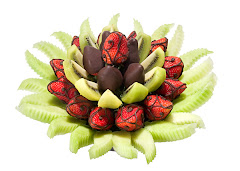Here in Tampa, we have had a beautiful spring. However, all good things must come to an end, at least that's what the saying claims. As May winds down, summer weather is already upon us. This means that local strawberries are pretty much a fond memory. Local blueberries are still available and there are nearby U-Pick blueberry farms in our area. Sweet blueberries are so good by themselves and they add a delicious shot of anti-oxidants to pancakes, waffles, smoothies, and salads.
While strawberries and blueberries may be the best known members of the berry family, and the ones that Flowers to Eat most often incorporates into our bouquets, trays and arrangements, there are many other types of berries available. Of course, there are the other readily available in grocery stores berries: raspberries, blackberries, and cranberries. But have you tried Cloudberries, Thimbleberries or Loganberries?
If you have visited the upper pennisula of Michigan, you may have tried Thimbleberry jam. Because they are very delicate and do not pack well, they are seldom sold commercially other than in the local areas in which they are grown.
Cloudberries grow wild across most of Alaska, Canada, and some of the northern-most continental United States. It is a botanical vestige of the Ice Ages and is under legal protection in parts of Germany. High in Vitamin C, the ripe fruits are golden-yellow, soft and juicy. They are made into a special beer in Canada. Wikipedia states that they are made into 'Eskimo Ice-Cream' in Alaska by mixing them with seal oil or reindeer or caribou fat. Hmm, I wonder if Ben and Jerrys has heard of this flavor?
Anyway, as summer approaches throughout the United States, we hope you will experiment with at least one berry or fruit that is new to you. Happy Exploring!
Tuesday, May 24, 2011
Subscribe to:
Posts (Atom)


